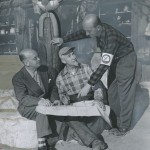
Poster courtesy John Miller, SBNF public information officer
New technology is typically a benefit, but recently it has become an impediment to firefighters, especially in Southern California.
Last week, drones were flying in the air space over the Lake and Sterling fires. On Wednesday evening, June 24, at the Lake Fire the U.S. Forest Service had to ground air tankers — which were full of retardant — because of the danger the unmanned aircraft systems or drones created, according to John Miller, public affairs officer for the San Bernardino National Forest.
“These were 3 to 4 feet in width,” Miller said, “and flying in the air space above the fire. We halted all operations in the air and called the planes back to the base in San Bernardino.” As a consequence, the Forest Service could not drop any retardant from about 5:15 p.m. until the next day.
One drone was spotted at 1,200 feet and its width was greater than 10 feet, according to Miller, who added that it missed a tanker by about 500 feet.
On Thursday, tanker operations on the Sterling Fire were also suspended because of UAS (Unmanned Aircraft Systems) over the fire.
Aerial firefighting aircraft, such as airtankers and helicopters, fly at very low altitudes, typically just a couple of hundred feet above the ground, the same as UAS flown by members of the public do, creating the potential for a mid-air collision that could seriously injure or kill aerial and/or ground firefighters, according to a release from the National Multi-Agency Coordinating Group.
If the Forest Service needs air resources to combat a fire, it requests temporary flight restrictions over the area from the Federal Aviation Administration. The presence of the drones violates these restrictions.
The public should not fly drones over or near wildfires even if a TFR is not in place. This is to prevent accidents and disruption of suppression operations. Individuals who are determined to have interfered with wildfire suppression efforts may be subject to civil penalties and potentially criminal prosecution, according to the FAA.
FAA guidance for members of the public flying UAS for hobby or recreation purposes is available online at http://www.faa.gov/uas/model_aircraft/.










